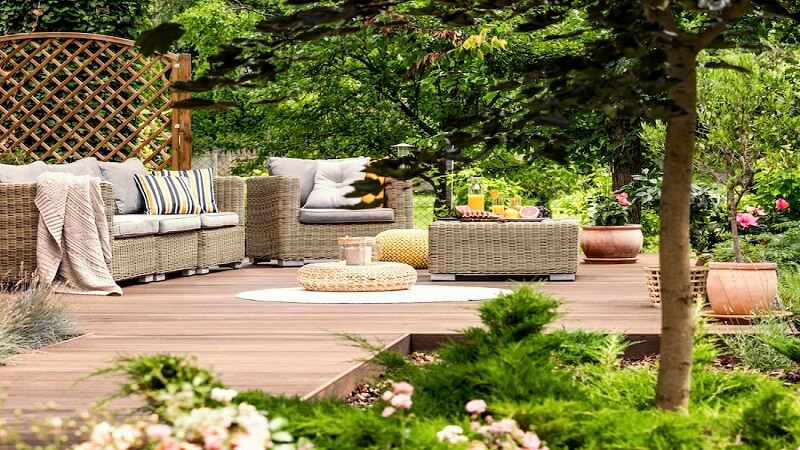Creating a functional outdoor living space is more than just adding a few chairs and a table to your backyard. It’s about designing an environment that extends your home’s comfort and style into the outdoors, providing a versatile area for relaxation, entertainment, and everyday living. With the growing trend of outdoor living, supported by a 2023 survey showing that 72% of homeowners prioritize backyard improvements, transforming your backyard can significantly enhance your lifestyle and even increase your property’s value.
Assessing Your Space and Setting Clear Goals
Before diving into design and construction, it’s essential to evaluate your backyard’s size, shape, and existing features. Take note of natural elements such as sunlight patterns, shade areas, and drainage. Understanding these factors will help you maximize the space’s potential and avoid costly mistakes.
In cases where drainage is an issue, professional irrigation repair can be a practical step before starting major landscaping work.
Consider Your Lifestyle and Needs
For families with children, incorporating a safe play area or durable surfaces might be a priority. For those who love hosting, a built-in grill, bar, or fire pit can create a welcoming atmosphere. Even pet owners should think about pet-friendly landscaping to ensure comfort for all household members. If you plan to add more permanent structures, such as pergolas or garden rooms, finding a good architect can make the difference between a project that simply looks appealing and one that is structurally sound and long-lasting.
Designing the Layout: Zones and Flow
Successful outdoor living spaces often feature distinct zones that serve different purposes while maintaining a cohesive flow. For example, a dining area can be adjacent to the kitchen access point, while a lounge zone with comfortable seating might be positioned to take advantage of sunset views.
Using natural dividers like hedges, planters, or pergolas can help define these zones without making the space feel cramped. Pathways constructed from stone, wood, or gravel not only guide movement but add texture and interest to the design.
Incorporate Multi-Functional Elements
Furniture and features that serve multiple purposes optimize space usage. For instance, benches with built-in storage can hide cushions or gardening tools, while a fire pit table can provide warmth and a surface for drinks and snacks. Such thoughtful design increases functionality without sacrificing style.
Choosing Durable and Comfortable Materials
Outdoor environments expose materials to weather extremes, so selecting durable and low-maintenance options is crucial. Composite decking, weather-resistant wicker, and powder-coated metals are popular choices that withstand sun, rain, and temperature changes.
Comfort is equally important. Invest in cushions and fabrics designed specifically for outdoor use, they resist fading, mildew, and moisture. Adding throw pillows and rugs made from synthetic fibers can create a cozy ambiance while being easy to clean.
Eco-Friendly and Sustainable Options
Many homeowners are now opting for sustainable materials such as reclaimed wood, bamboo, or recycled plastics. These choices reduce environmental impact and often bring unique textures and colors to the space, enhancing its aesthetic appeal.
Integrating Lighting for Ambiance and Safety
Lighting transforms an outdoor living area from functional to magical. Layered lighting—combining ambient, task, and accent lights—ensures the space is usable after dark and highlights key features.
Solar-powered LED lights along pathways and garden beds provide energy-efficient illumination without wiring hassles. String lights overhead create a festive atmosphere, while lanterns and sconces add warmth and charm.
Smart Lighting Controls
Modern outdoor lighting systems can be integrated with smart home technology, allowing you to adjust brightness and color or set timers via smartphone apps. This convenience enhances usability and energy efficiency.
Adding Greenery and Water Features
Plants bring life and color to outdoor living areas, improving air quality and creating a natural retreat. Select a mix of perennials, shrubs, and trees suited to your climate and soil conditions to ensure longevity and ease of care.
Water features such as fountains, ponds, or small waterfalls introduce soothing sounds that enhance relaxation. Beyond aesthetics, they can also attract birds and beneficial insects, contributing to a balanced ecosystem.
Vertical Gardens and Container Planting
If space is limited, vertical gardens and container plants offer creative ways to incorporate greenery without sacrificing floor area. They can also serve as privacy screens or decorative focal points.
Incorporating Functional Amenities
To truly make your backyard an extension of your home, consider adding amenities that enhance convenience and enjoyment. Outdoor kitchens, weatherproof entertainment systems, and heating elements like fire pits or patio heaters extend usability through different seasons.
Storage solutions such as sheds or built-in cabinets keep tools and accessories organized and protected from the elements, maintaining a tidy and inviting space.
Planning for Maintenance
Design your outdoor living area with maintenance in mind. Choosing native plants, installing automated irrigation, and selecting durable materials reduce upkeep time and costs, allowing you to enjoy your space rather than constantly working on it.
Final Thoughts: Balancing Style, Comfort, and Practicality
Transforming your backyard into a functional outdoor living area is a rewarding project that enhances your home’s value and your quality of life. By carefully assessing your space, defining goals, and thoughtfully selecting design elements and materials, you can create an inviting environment tailored to your lifestyle.
Remember that the best outdoor living areas balance beauty with practicality, comfort with durability, and personal style with universal appeal. Whether you’re hosting summer barbecues or enjoying quiet mornings with a cup of coffee, a well-designed backyard space can become your favorite room in the house.
